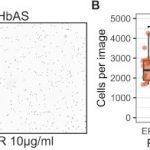Sickle-cell trait hemoglobin mutations (HbAS) are known to protect against Plasmodium falciparum malaria. In a recent clinical trial Jens E. V. Petersen et al, investigated the mechanism behind this.
“Severe malaria is governed in part by the expression of the Plasmodium falciparum Erythrocyte Membrane Protein 1 (PfEMP1) that are encoded by var genes, specifically those variants that bind Endothelial Protein C Receptor (EPCR).”
The researchers investigated the effect of the sickle-cell trait on var gene expression and function in Malian children in vitro and in field-collected parasites, including the var genes that illicit severe malaria by mediating infected erythrocyte adhesion to host EPCR.
Parasite RNA was compared in sickle-cell trait and non-sickle-cell trait children and the data showed that HbAS does not affect overall var transcription or the type of var genes expressed but does reduce “parasites ability to adhere to both CD36 and EPCR in vitro, by attenuating the expression of parasite proteins (PfEMP1) on the erythrocyte surface”.
“In adhesion assays using recombinant host receptors, sickle-trait reduced adhesion by 73–86% to CD36 and 83% to EPCR.”
The researchers concluded that sickle-cell trait does not have a direct effect on var gene transcription but does reduce the surface expression and function of PfEMP1. This study may provide a direct mechanism that explains how the sickle-cell hemoglobin trait protects against severe malaria.

Sickle-trait hemoglobin effects on erythrocyte adhesion to EPCR.
A) Erythrocytes infected with IT4 parasite-strain expressing IT4var20 adhering to spots of recombinant EPCR on a petri-dish. B) Quantification of IT4var20-infected normal (HbAA) erythrocytes and sickle-cell trait (HbAS) erythrocytes adhesion to 10 μg/ml EPCR and CD36 spots. Each condition was done as 2 protein spots on separate petri-dishes, each imaged 3 times. The assay was done 3 independent times (n = 3). Wilcoxon’s signed rank test was used to evaluate statistical significance (** p-value = 0.0002). C) Relative adhesion across protein spots at different concentrations normalized to the mean adhesion to EPCR at 10 μg/ml. Four parameter logistic curve was fitted to the normalized data for HbAA and HbAS. (Source: Petersen et al, 2021)
Find out more about Malaria – Immunity to Malaria
Journal Article: Petersen et al. 2021. Sickle-trait hemoglobin reduces adhesion to both CD36 and EPCR by Plasmodium falciparum-infected erythrocytes. PLOS Pathogens.
Summary by Bonamy Holtak
